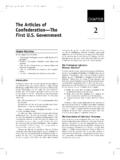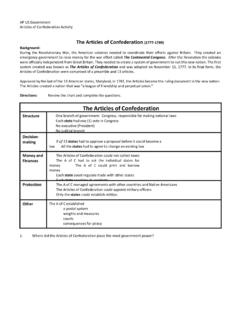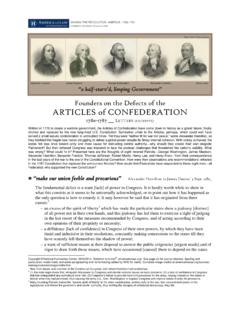Transcription of SECTION 3: Articles of Confederation - World History Honors
1 Chapter 2 SECTION 3: Articles of Confederation (pg. 47 50) Copyright by Holt McDougal. All rights reserved. Chapter 2, SECTION 3 1 of 2 GOV 101 Main Idea The states first attempt to build a national government, the Articles of Confederation , proved too weak to last. Reading Focus 1. How was the first national government organized under the Articles of Confederation ? 2. What were the weaknesses of the Articles of Confederation ? 3. What events convinced some American leaders that a stronger national government was needed?
2 Key Terms Articles of Confederation ratified Northwest Ordinance Shays s Rebellion First National Government (pg. 48) In June 1776 the Second Continental Congress appointed a committee to draw up a plan for the new government. The committee created a document that would create a Confederation a firm league of friendship among the independent states. On June 12, 1777, after six drafts and several months of debate, Congress adopted the nation s first constitution, the Articles of Confederation . Before it could go into force, it had to be ratified, or formally approved, by all of the states. Several disputes, including one involving which state would control lands to the west, delayed ratification.
3 To win approval, the authors of the Articles gave the Confederation control over western lands. The last state ratified the Articles in 1781. The Articles gave several powers to the new government but also limited the government. Powers of Congress included: Coin and borrow money Admit new states and divide western lands Request money from states Raise an army Appoint military officers Establish a postal system Declare war and make peace Conduct foreign affairs Limits on powers were: No president or executive branch No national court system No power to tax or raise national funds No power to regulate trade or currency No power to prohibit states from conducting foreign affairs Major laws required the approval of nine states to pass The states kept all powers not given to Congress.
4 This meant they could collect taxes and enforce national laws. They could also determine how they would contribute funds to the national government. Reading Check Identifying the Main Idea What were some of the powers of Congress? Chapter 2, SECTION 3 continued Copyright by Holt McDougal. All rights reserved. Chapter 2, SECTION 3 2 of 2 GOV 101 Weaknesses of the Articles (pg. 48 49) The limits placed on the government s power by the Articles kept Congress from governing effectively. There was no executive to enforce the laws.
5 Congress had no power to tax. It also could not regulate trade between the states. Rarely could 9 of the 13 states agree to pass laws. Congress could not act quickly. Reading Check Identifying the Main Idea How were the Articles weak? Pressures for Stronger Government (pg. 49 50) After independence from Britain with the Treaty of Paris of 1783, one of Congress s greatest successes was the passage of the Northwest Ordinance of 1787. The ordinance established a plan for settling the Northwest Territory. It allowed for admitting new states to the Union, banned slavery in the territory, and included a bill of rights for people in the territory. Other challenges war debts, a sluggish economy, uncooperative states, and unrest in the country were harder to manage.
6 The states would not agree to taxes to pay the war debts. The government had no money. States made their own laws and negotiated with foreign governments. The economy was slow to recover after the war, and farmers feared losing their lands. In September 1786 a small band of Massachusetts farmers rebelled. Led by former Revolutionary War captain Daniel Shays, the farmers attacked courthouses to prevent judges from taking their farms. By 1787, the ranks of Shays s Rebellion had swelled to nearly 2,500. Congress could not help the situation because it had no forces or money to offer. A Massachusetts state militia finally stopped the mob. In March 1785 George Washington called a meeting between Virginia and Maryland to discuss a trade dispute.
7 The meeting s success led James Madison to call another larger meeting at Annapolis, Maryland, to discuss trade among the states. Poor attendance led attendees to schedule another meeting for May 1787 in Philadelphia. Madison asked the Confederation Congress to support the meeting, which was to be held to revise the Articles to solve some of the national government s problems. Reading Check Summarizing Why did leaders to want to revise the Articles ? SECTION 3 ASSESSMENT 1. Recall What issue led to the delay of the ratification of the Articles of Confederation ? 2. Identify What weakness in the Articles prevented Congress from financing its activities? 3. Identify What was Shays s Rebellion?
8




![How does the Constitution fix the problems of [Read-Only]](/cache/preview/e/2/0/0/5/2/b/c/thumb-e20052bc43a34061661c152e09c57e7d.jpg)




